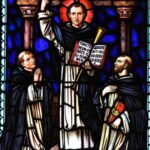St. Irenaeus
St. Irenaeus
When They Lived
St. Irenaeus lived in the late 2nd century, from approximately 130 AD to 202 AD.
Where They Lived
St. Irenaeus resided primarily in Lugdunum (modern-day Lyon, France), which was a significant center of early Christianity in the Roman Empire.
Notable World Events During Their Time
- Roman Empire at its Height: St. Irenaeus lived during the Pax Romana, a period of relative peace and stability within the Roman Empire. This allowed for the spread of ideas and culture, including the growth of Christianity.
- Bar Kokhba Revolt (132-136 AD): A Jewish rebellion against Roman rule in Judea, led by Simon Bar Kokhba. This event had implications for both Judaism and the broader Roman Empire.
- Antonine Plague (165-180 AD): A pandemic believed to be either smallpox or measles, which devastated the Roman Empire during this time. It had significant socio-economic and demographic impacts.
- Persecutions of Christians: St. Irenaeus lived during a period of sporadic persecutions of Christians under various Roman emperors, including Marcus Aurelius. These persecutions shaped the early Christian experience and theology.
- Han Dynasty Collapse (220 AD): The end of the Han Dynasty in China marked a major political and cultural shift in East Asia, impacting trade routes and global dynamics.
- Claudius Ptolemy’s Works: During St. Irenaeus’ time, the influential astronomer and mathematician Claudius Ptolemy was active, producing works that would shape scientific understanding for centuries.
Patronage
St. Irenaeus is known as the patron saint of theologians and bookbinders. His significant contributions to Christian theology, especially through his defense of orthodoxy against heretical movements, have earned him a place of honor among theologians. As the author of “Against Heresies,” he tackled various theological controversies of his time, asserting the importance of apostolic tradition and the authority of the four Gospels. St. Irenaeus’ emphasis on the unity of faith and his engagement with diverse theological perspectives make him a compelling figure for those interested in the development of Christian doctrine.
A Mission to Rome Saved him.
Little is known about the early life of St. Irenaeus. The facts about him are not extremely clear or plentiful. He was born in Asia, most probably in the city of Smyrna, modern-day Izmir, in Turkey. He was born around 135–140. In his younger years, Irenaeus attended the school of the bishop of Smyrna, St. Polycarp, a disciple in his turn of the Apostle and Evangelist John.
Nothing is known about the exact date of his journey from Asia Minor to Gaul. However, Irenaeus must have moved, coinciding with the first development of the Christian community in Lyons. In 177, Irenaeus was listed in the college of presbyters. That same year, he was sent to Rome with a letter from the community in Lyons, which was given to Pope Eleutherius.
Iranaeus’ mission to Rome spared him from the persecution under Emperor Marcus Aurelius, which resulted in the deaths of at least 48 martyrs, including Pontinus of Lyons, the 90-year-old bishop, who died from mistreatment in prison. Thus, on his return to Lyons around 178, Irenaeus was appointed bishop of the city.
A Zealous Bishop for Lyons
Irenaeus learned the languages of the people in order to evangelize and teach the Germanic and Celtic tribes, whom the Romans considered barbarians. The new shepherd devoted himself to his episcopal ministry, distinguished on account of his missionary zeal and the theological richness of his doctrines. He had a good sense of proportion, a wealth of doctrine, and missionary enthusiasm.
As a writer, Irenaeus pursued a twofold goal: to defend the true and authentic doctrine from the attacks of heretics and to explain the truth of the faith clearly. His works testified to this and exactly corresponded with these aims. The second-century Church was threatened by the so-called Gnosis, a doctrine or movement that believed the faith taught in the Church was only symbolic. The Gnostics claimed they were the ones who could understand what was behind these symbols, thus creating an elitist and intellectualist Christianity. He bravely and intelligently fought the heresy of Gnosticism.
Irenaeus’ term as the Bishop of Lyons came to an end around 202–203. There is a later tradition that he was martyred under the persecution of Septimus Severus. The bodily remains of St. Irenaeus were buried in a crypt under the altar of what was then called the church of St. John but was later known by the name of St. Irenaeus himself. This tomb or shrine was destroyed by the Calvinists in 1562, and all traces of his relics seem to have perished. His feast day is June 28.
Five Interesting Facts About St. Irenaeus
- Two of St. Irenaeus’ major writings are still existing today: Against Heresies and The Demonstration of the Apostolic Preaching.
- In the course of his writings, St. Irenaeus advanced the development of an authoritative canon of Scriptures, the Creed, and the authority of the episcopal office.
- St. Irenaeus is the patron saint of apologists and catechists.
- The name “Irenaeus” means “Peacemaker”.
- Some sources claim that when he was in Rome, St. Irenaeus studied under St. Justin Martyr, another apologist and philosopher.
Prayer to St. Irenaeus
O God, who called the Bishop Saint Irenaeus to confirm true doctrine and the peace of the Church, grant, we pray, through his intercession, that, being renewed in faith and charity, we may always be intent on fostering unity and concord. Through our Lord Jesus Christ, your Son, who lives and reigns with you in the unity of the Holy Spirit, one God, for ever and ever Amen.



